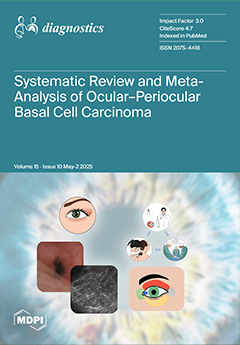Background/Objectives: To investigate the effect of strabismus surgery on ocular surface parameters, meibomian glands, and conjunctival impression cytology.
Methods: Preoperative and postoperative (10th day, first month, and third month) tear break-up time (TBUT) tests, Schirmer 1 tests, corneal staining scores (CSS),
[...] Read more.
Background/Objectives: To investigate the effect of strabismus surgery on ocular surface parameters, meibomian glands, and conjunctival impression cytology.
Methods: Preoperative and postoperative (10th day, first month, and third month) tear break-up time (TBUT) tests, Schirmer 1 tests, corneal staining scores (CSS), meibomian gland (MG) loss rates, ocular surface disease index (OSDI) scores, and conjunctival impression cytology (IC) results of 30 patients who underwent strabismus surgery were compared.
Results: Significant differences were found between preoperative TBUT test results and those evaluated on the postoperative 10th day and at the postoperative first month (
p < 0.0001 for both). There were also significant differences between the preoperative and postoperative first- and third-month Schirmer 1 test results (
p = 0.02 and
p < 0.0001, respectively). Furthermore, mean OSDI scores significantly differed between preoperative and postoperative 10th-day measurements (
p < 0.0001). The mean postoperative 10th-day CSS was found to be significantly higher than the preoperative mean CSS (
p < 0.0001). The stages in preoperative conjunctival IC samples were found to be significantly lower than those evaluated at all postoperative times (
p < 0.0001 for all). Significant differences were observed between the preoperative lower eyelid MG loss rate and all postoperative MG loss rates (
p < 0.0001 for the 10th day and first month and
p < 0.001 for the third month). Lastly, the preoperative upper eyelid MG loss rate significantly differed from all postoperative MG loss rates (
p < 0.0001 for the 10th day,
p < 0.003 for the first month, and
p < 0.0001 for the third month).
Conclusions: We observed changes indicative of dry eye in the mean OSDI score, TBUT, Schirmer 1 test, MG loss rates, and conjunctival IC findings up to the postoperative third month in patients who underwent strabismus surgery. Therefore, we believe that patients undergoing strabismus surgery should be followed up for ocular surface diseases, particularly dry eye.
Full article






